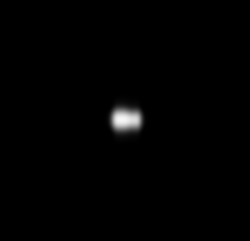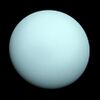Cupid (moon)
Topic: Astronomy
 From HandWiki - Reading time: 3 min
From HandWiki - Reading time: 3 min
 | |
| Discovery | |
|---|---|
| Discovered by | Mark R. Showalter and Jack J. Lissauer |
| Discovery date | August 25, 2003 |
| Designations | |
Designation | Uranus XXVII |
| Pronunciation | /ˈkjuːpəd/ |
| Adjectives | Cupidian /kjuːˈpɪdiən/[1] |
| Orbital characteristics | |
| 74,392 km | |
| Eccentricity | 0.0013 |
| Orbital period | 0.618 d |
| Inclination | 0.1° (to Uranus' equator) |
| Satellite of | Uranus |
| Physical characteristics | |
| Mean radius | ~9 km[2] |
| Surface area | ~1,000 km2 |
| Volume | ~3,000 km3 |
| Mass | ~3.8×1015 kg |
| Mean density | ~1.3 g/cm3 |
| ~0.0031 m/s2 | |
| ~0.0076 km/s | |
| Rotation period | synchronous |
| Axial tilt | 0 |
| Albedo | 0.07 (assumed) |
| Physics | ~64 K |
Cupid is an inner satellite of Uranus. It was discovered by Mark R. Showalter and Jack J. Lissauer in 2003 using the Hubble Space Telescope.[3] It was named after a character in William Shakespeare's play Timon of Athens.[4]
It is the smallest known inner Uranian satellite, crudely estimated to be only about 18 km in diameter. This and the dark surface made it too dim to be detected by the Voyager 2 cameras during its Uranus flyby in 1986.
The orbit of Cupid differs only by 863 km from the orbit of the larger moon Belinda. Unlike Mab and Perdita, Uranian satellites also discovered in 2003, it does not seem to be perturbed.[2] Despite this, it has the least stable orbit of Uranus's inner moons — it is likely to collide with Belinda in the next 100,000–10 million years, due to resonance interactions that cause the smaller Cupid to drift into a more dangerous orbit over this timescale.[5]
Following its discovery, Cupid was given the temporary designation S/2003 U 2.[3] It is also designated Uranus XXVII.[4]
It should not be confused with the asteroid 763 Cupido.
References
- ↑ Tanner & Barnet (1995) Comedies
- ↑ 2.0 2.1 Showalter, Mark R.; Lissauer, Jack J. (2006-02-17). "The Second Ring-Moon System of Uranus: Discovery and Dynamics". Science 311 (5763): 973–977. doi:10.1126/science.1122882. PMID 16373533. Bibcode: 2006Sci...311..973S.
- ↑ 3.0 3.1 Showalter, Mark R.; Lissauer, Jack J. (September 25, 2003). "S/2003 U 1 and S/2003 U 2". IAU Circular 8209: 1. ISSN 0081-0304. Bibcode: 2003IAUC.8209....1S. http://www.cbat.eps.harvard.edu/iauc/08200/08209.html. Retrieved 2011-11-02.
- ↑ 4.0 4.1 "Planet and Satellite Names and Discoverers". Gazetteer of Planetary Nomenclature. USGS Astrogeology. July 21, 2006. http://planetarynames.wr.usgs.gov/Page/Planets.
- ↑ French, Robert S.; Showalter, Mark R. (August 2012). "Cupid is doomed: An analysis of the stability of the inner uranian satellites". Icarus 220 (2): 911–921. doi:10.1016/j.icarus.2012.06.031. Bibcode: 2012Icar..220..911F.
External links
- Hubble Uncovers Smallest Moons Yet Seen Around Uranus – Hubble Space Telescope news release (25 September 2003)
 |
 KSF
KSF

